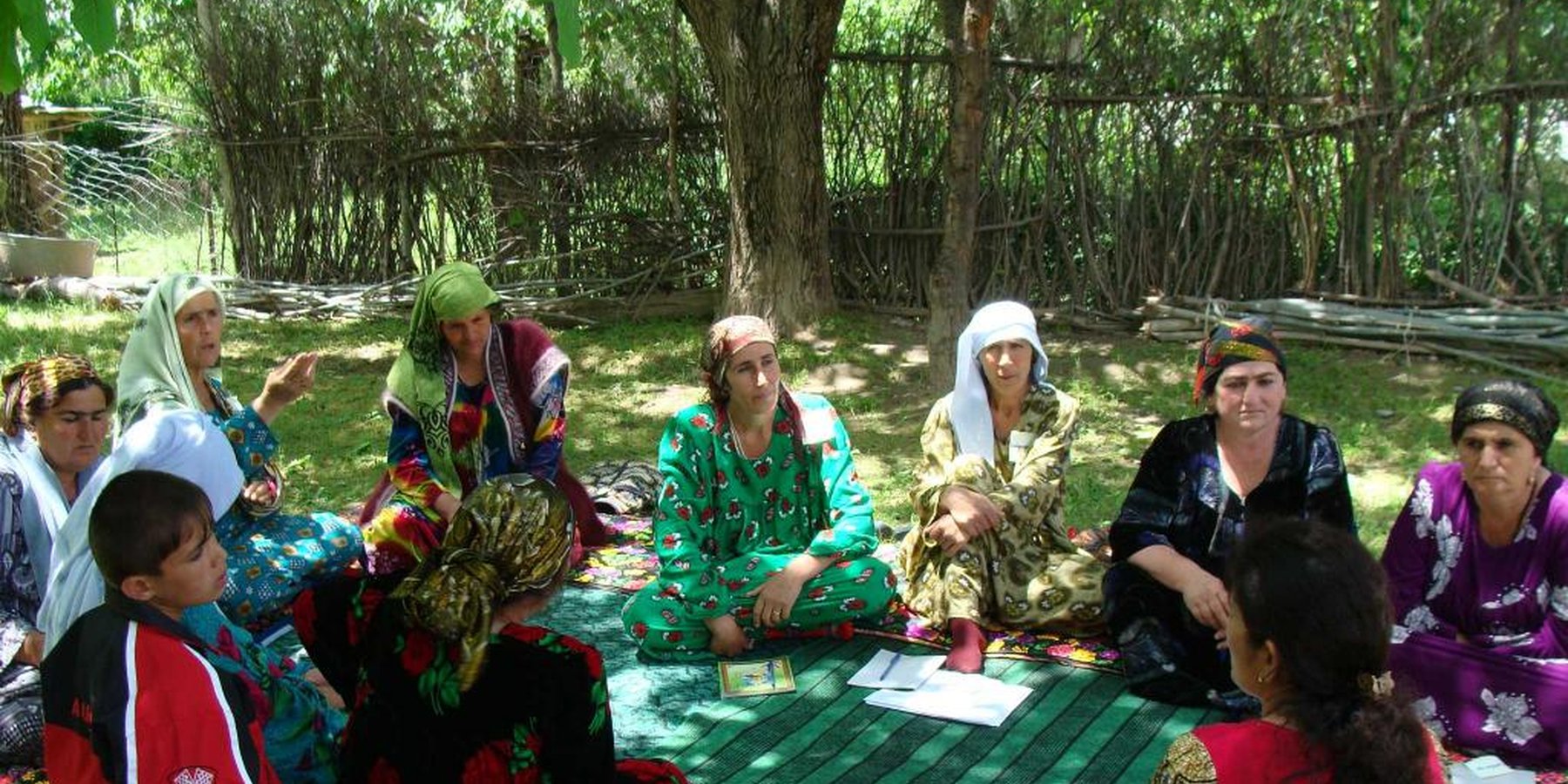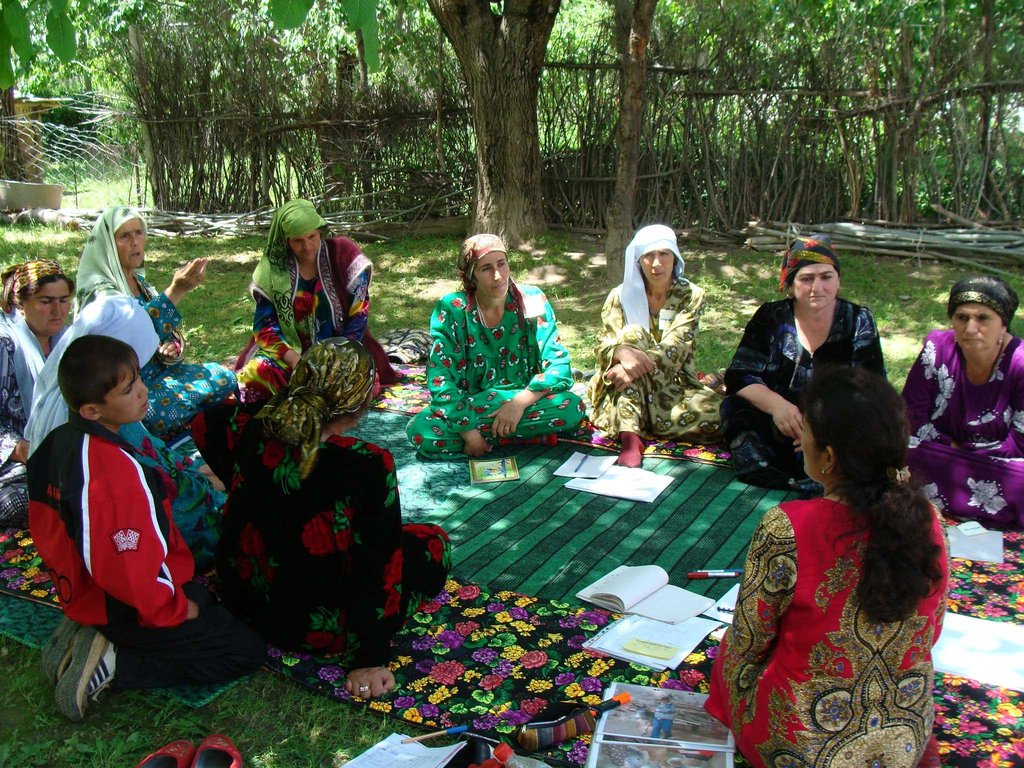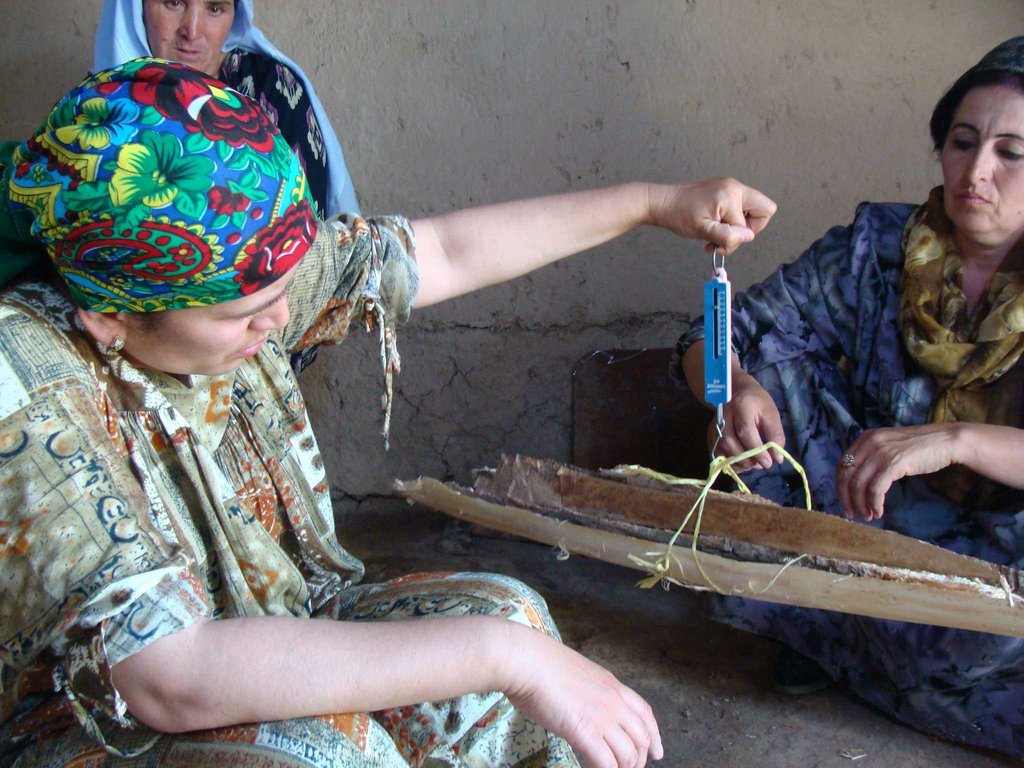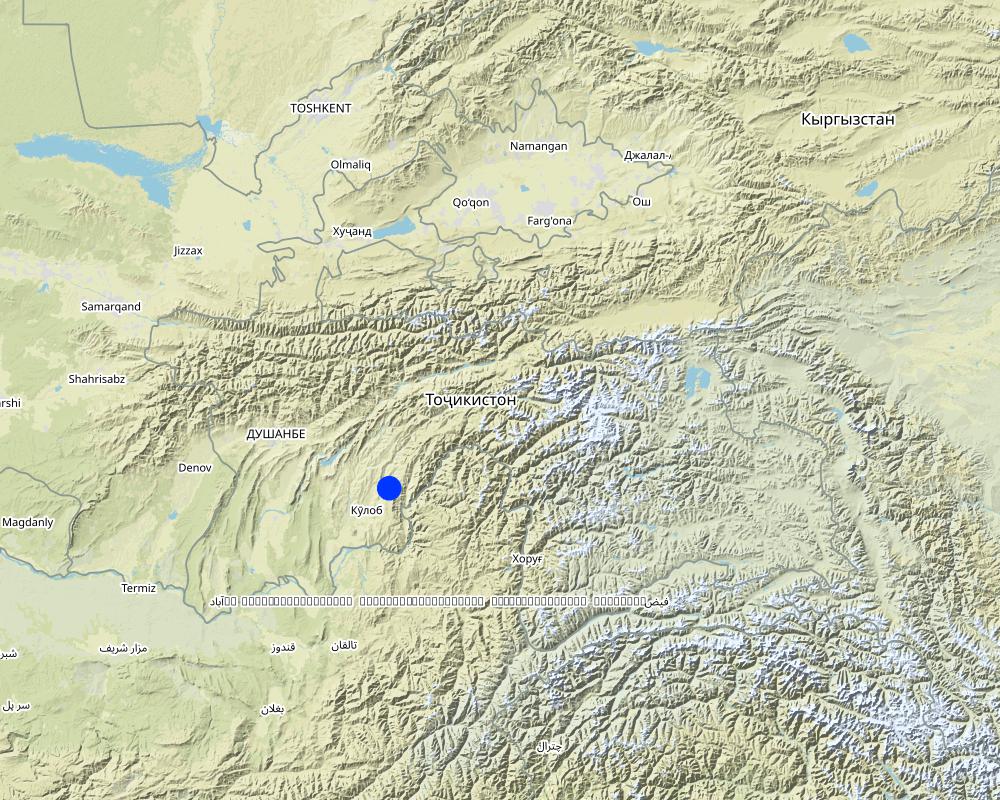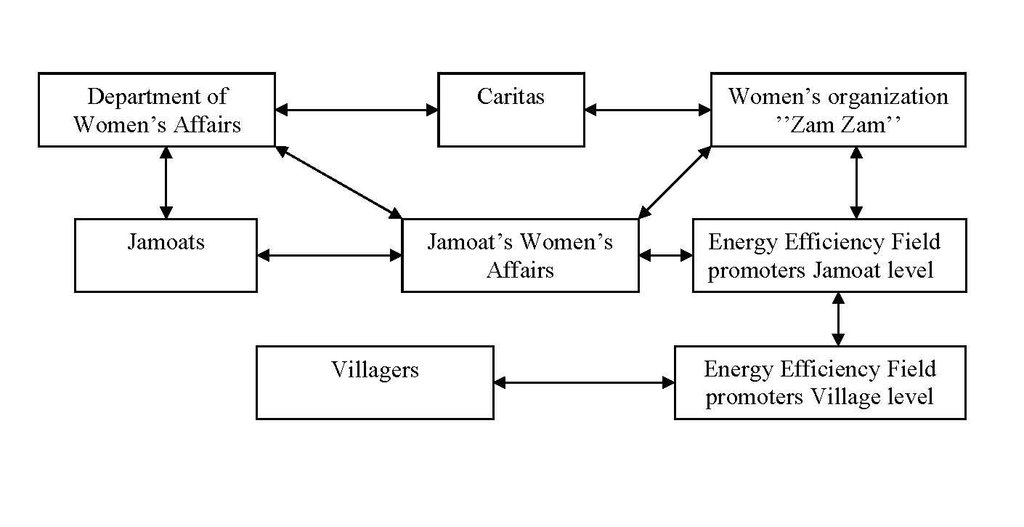Implementation through the government's Women's Affair Officers. [Tajikistan]
- Creation:
- Update:
- Compiler: Sa'dy Odinashoev
- Editor: –
- Reviewers: David Streiff, Alexandra Gavilano, Joana Eichenberger
approaches_2449 - Tajikistan
View sections
Expand all Collapse all1. General information
1.2 Contact details of resource persons and institutions involved in the assessment and documentation of the Approach
SLM specialist:
Name of project which facilitated the documentation/ evaluation of the Approach (if relevant)
Pilot Program for Climate Resilience, Tajikistan (WB / PPCR)1.3 Conditions regarding the use of data documented through WOCAT
When were the data compiled (in the field)?
06/07/2009
The compiler and key resource person(s) accept the conditions regarding the use of data documented through WOCAT:
Yes
2. Description of the SLM Approach
2.1 Short description of the Approach
The use of the government appointed District Womens Affair Officer to mobilise women throughout the community to implement technologies.
2.2 Detailed description of the Approach
Detailed description of the Approach:
Aims / objectives: The aim of the approach was to empower women through support from the government’s Women's Affairs Officer (WAO), to implement low cost energy efficient technologies within individual households. Women being the primary users of energy within the household, can become the main agents for change in applying more efficient methods to the use of natural resources to meet their cooking, heating and energy needs. Therefore, reducing fuel costs, and dependence upon local natural resources. The district local government employs a WAO, who is the government representative for women’s issues in the district. Once the WAO became supportive of the idea, she was able to engage the Women’s Affairs Officers at the Jamoat level.
Methods: This approach is fundamentally a training pyramid approach. An expert conducted a series of training sessions to interested women on the details of the technology. The training involves demonstrations of the technology, it's benefits, information on how to purchase or make the material required, and how to implement the technology. The first session is a ‘Training of Trainers’. The participants are then provided with training materials, and are invited to replicate the training in their own community. The process is continuously repeated, subsequently broadening the target audience. Zamzam, the local women’s association of the district helped suggest potential community candidates for trainers, and provided practical training sessions on energy efficiency measures through the TOT.
Stages of implementation: The implementation of the project started with an inception meeting with the District Women’s Affairs Officer to sell the idea, and to gain the local government’s support. Once she was supportive of the idea, a district level meeting was held with all the Women’s Affairs Officers at the local level (i.e. Jamoat) and two women representatives from each Jamoat. At this meeting the ladies were introduced to the technology i.e. cooking stove modification and heat exchangers. The meeting further discussed on how each jamoat would receive training, and what training materials were to be distributed to the communities. The meeting enabled issues with the technology, logistics, monitoring and overall set up of the approach to be discussed. Afterwards an expert trained a group of women from each Jamoat on the technology and provided them with materials so that the training could be repeated within their own communities.
Role of stakeholders: This is a women's led approach, the Women’s' representative within the government, who are also Women’s association members, were responsible for organisation of the trainers, logistics and government documentation support. With support from Zamzam, the active women in the community were selected as trainers to receive training from the experts and provide subsequent outreach training to their communities.
2.3 Photos of the Approach
2.5 Country/ region/ locations where the Approach has been applied
Country:
Tajikistan
Region/ State/ Province:
Khatlon
Further specification of location:
Muminabad
Map
×2.6 Dates of initiation and termination of the Approach
Indicate year of initiation:
2009
Year of termination (if Approach is no longer applied):
2010
2.7 Type of Approach
- governmental
2.8 Main aims/ objectives of the Approach
The Approach focused mainly on SLM with other activities (Energy Efficiency)
The aim of the approach was to mobilise the women within the community through the use of the government appointed District Women's Affairs Officer. Once the government appointee was engaged in the promotion of the technology, she was able to use her position to mobilise the Women's Representative at the local government level (Jamoat), and subsequently women's representatives within each village level. The approach exploits the existing government's women's network to empower women to implement technologies, whilst also gaining government support and assistance.
The SLM Approach addressed the following problems: The average household in the Muminabad area uses several tonnes of tapak (dung and straw mix) and firewood each year for cooking, baking and heating. This puts excessive strain on the local natural resources, and significantly reduces the amount of organic fertiliser used in land management, as well as the removal of tree and shrubs that stabilise the land and help prevent erosion from wind, surface water run off and livestock grazing.
2.9 Conditions enabling or hindering implementation of the Technology/ Technologies applied under the Approach
availability/ access to financial resources and services
- hindering
At the beginning women did not know that modification of the cookingstoves were not expensive, and were initially not interested in learning about the adaptation.
Treatment through the SLM Approach: Demonstration of the technolgy and explanation of the costs.
institutional setting
- hindering
The women have been using the same style of outdoor cooking stove for many years and did not consider or were open to changing the design.
Treatment through the SLM Approach: A group workshop created an open environment in which the women could think about their energy use, their cooking equipment and discuss potential changes.
3. Participation and roles of stakeholders involved
3.1 Stakeholders involved in the Approach and their roles
- local land users/ local communities
Women's group to conduct training on the technology and women in households
The active women in the village were selected to disseminate information
- SLM specialists/ agricultural advisers
To organise the training materials.
- local government
District and local government women's affairs officers.
The entire approach was developed to engage women, as they would be the ones that would benefit most from the technology.
- international organization
Provided the funding and monitoring.
3.2 Involvement of local land users/ local communities in the different phases of the Approach
| Involvement of local land users/ local communities | Specify who was involved and describe activities | |
|---|---|---|
| initiation/ motivation | self-mobilization | It was members of the local community that thought of the idea and approached the governments Women's Affair Officer. |
| planning | interactive | The local stakeholders organised a initial meeting to plan the implementation of the approach. |
| implementation | self-mobilization | Implementation was entirely through the local community, including government representatives at district and local level. |
| monitoring/ evaluation | external support | This was undertaken by the donor and at the district level. |
| Research | none | None |
3.3 Flow chart (if available)
Description:
An organisational chart showing how all the organisations worked together on the project.
Author:
Odinashoev, Sa (Muminabad, Tajikistan)
3.4 Decision-making on the selection of SLM Technology/ Technologies
Specify who decided on the selection of the Technology/ Technologies to be implemented:
- mainly land users, supported by SLM specialists
Explain:
The idea for the approach was developed by representatives of the local community, who were interested in implementing a technology that would improve the lives of women in the community.
Decisions on the method of implementing the SLM Technology were made by mainly by SLM specialists with consultation of land users. The technology of improved cooking stoves was already developed, tried and tested, the approach orginated from already knowing which technology to implement.
4. Technical support, capacity building, and knowledge management
4.1 Capacity building/ training
Was training provided to land users/ other stakeholders?
Yes
Specify who was trained:
- field staff/ advisers
- Women's groups
If relevant, specify gender, age, status, ethnicity, etc.
The project personnel provided the initial training to the women, who in turn then trained within their own communities.
Form of training:
- farmer-to-farmer
- demonstration areas
Form of training:
- Training was held within the communties.
Subjects covered:
The training was on energy efficiency measures, and how to reduce the amount of organic material used as fuel.
4.2 Advisory service
Do land users have access to an advisory service?
No
4.3 Institution strengthening (organizational development)
Have institutions been established or strengthened through the Approach?
- yes, greatly
Specify the level(s) at which institutions have been strengthened or established:
- local
Specify type of support:
- capacity building/ training
Give further details:
Local NGO Zam Zam, a women's network, was used to conduct the training.
4.4 Monitoring and evaluation
Is monitoring and evaluation part of the Approach?
Yes
Comments:
no. of land users involved aspects were regular monitored by project staff through observations; indicators: The quality of the training was observed.
no. of land users involved aspects were regular monitored by project staff through measurements; indicators: The number of women that received training was monitored.
There were no changes in the Approach as a result of monitoring and evaluation: None
There were no changes in the Technology as a result of monitoring and evaluation: None
4.5 Research
Was research part of the Approach?
Yes
5. Financing and external material support
5.1 Annual budget for the SLM component of the Approach
If precise annual budget is not known, indicate range:
- 2,000-10,000
Comments (e.g. main sources of funding/ major donors):
Approach costs were met by the following donors: government (Government covered costs related to workshop for women's groups): 10.0%; international non-government (Covered the expenses such as travel and materials.): 90.0%
5.2 Financial/ material support provided to land users
Did land users receive financial/ material support for implementing the Technology/ Technologies?
Yes
If yes, specify type(s) of support, conditions, and provider(s):
The state provided personnel support and facilities for meetings
5.3 Subsidies for specific inputs (including labour)
- equipment
| Specify which inputs were subsidised | To which extent | Specify subsidies |
|---|---|---|
| metal door | partly financed | |
- other
| Other (specify) | To which extent | Specify subsidies |
|---|---|---|
| transport cost | fully financed | fuel, taxi |
If labour by land users was a substantial input, was it:
- voluntary
Comments:
It is a relatively low cost approach that required traing materials, transport and demonstration equipment. The main part of the finance was required for the implementation stage of the technology, whereby half the costs were met by the land user and the rest by the donor.
5.4 Credit
Was credit provided under the Approach for SLM activities?
No
6. Impact analysis and concluding statements
6.1 Impacts of the Approach
Did the Approach help land users to implement and maintain SLM Technologies?
- No
- Yes, little
- Yes, moderately
- Yes, greatly
The approach helped raise awareness on how to reduce the amount of organic material needed to meet the domestic fuel needs, and the saved material could be used as organic fertiliser.
Did the Approach empower socially and economically disadvantaged groups?
- No
- Yes, little
- Yes, moderately
- Yes, greatly
It improved the cooking conditions of women, and reduced their workload in the collation of natural resources to meet the household fuel needs.
Did the Approach improve issues of land tenure/ user rights that hindered implementation of SLM Technologies?
- No
- Yes, little
- Yes, moderately
- Yes, greatly
Did other land users / projects adopt the Approach?
- No
- Yes, little
- Yes, moderately
- Yes, greatly
Did the Approach lead to improved livelihoods / human well-being?
- No
- Yes, little
- Yes, moderately
- Yes, greatly
The associated technology helped reduce smoke in the kitchens and a reduction in the amount of time, resources and finance that was spent on household fuel.
Did the Approach help to alleviate poverty?
- No
- Yes, little
- Yes, moderately
- Yes, greatly
It helped reduce the amount of money spent on fuel and helped preserve natural resources.
6.2 Main motivation of land users to implement SLM
- increased profit(ability), improved cost-benefit-ratio
Reduce money spent on fuel.
- reduced workload
The associated technologies helped reduce workload.
- rules and regulations (fines)/ enforcement
The endorsement by the district government helped influence adoption rates.
- prestige, social pressure/ social cohesion
The approach tried to include as many women as possible, the social pressure to participate grew.
- affiliation to movement/ project/ group/ networks
To a degree there was empowerment of women.
- environmental consciousness
Reducing the amount of smoke in the outdoor kitchen
- well-being and livelihoods improvement
Hopefully improvement in health from less smoke, less money spent on fuel and less workload.
6.3 Sustainability of Approach activities
Can the land users sustain what has been implemented through the Approach (without external support)?
- yes
If yes, describe how:
The approach needs minimal finance to continue.
6.4 Strengths/ advantages of the Approach
| Strengths/ advantages/ opportunities in the land user’s view |
|---|
| It is easy to train a group of women, it is much harder to train men. (How to sustain/ enhance this strength: The women could benefit from further instructions on how to train. ) |
| Strengths/ advantages/ opportunities in the compiler’s or other key resource person’s view |
|---|
| The approach incorporates government support. (How to sustain/ enhance this strength: It may mean that further approaches and endorsements will have government support and generate further interest from the authorites.) |
| The approach is easy to replicate and has the potential to reach many beneficaries. (How to sustain/ enhance this strength: It could be replicated in other areas and regions. ) |
| The approach is designed specifically for the target beneficaries. (How to sustain/ enhance this strength: Other technologies that specifically benefit women could adopt this approach.) |
6.5 Weaknesses/ disadvantages of the Approach and ways of overcoming them
| Weaknesses/ disadvantages/ risks in the compiler’s or other key resource person’s view | How can they be overcome? |
|---|---|
| Because the approach is specifically for women it could limit the uptake by men. | Maybe subsequent training sessions could be held for men. |
| Some of the poorer households were not in a position to contribute to buying the materials or to implement the technology. This, therefore, exclused the poorest in the community. | Other memebers of the community could provide support. It should be noted that any contribution no matter how small puts a financial worth on the technology. |
7. References and links
7.1 Methods/ sources of information
- field visits, field surveys
- interviews with land users
Links and modules
Expand all Collapse allLinks
No links
Modules
No modules


